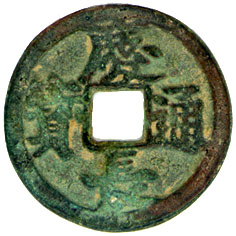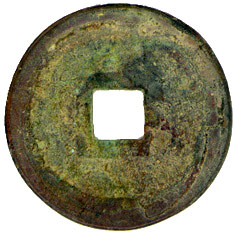| Obverse | Reverse | Description |
 |
 | No. 199 |
| Diam. 23 mm | ||
| Wt. 3 g. | ||
| Rareness D | ||
| Mint Evolution & Peculiarity | ||
| This Ch'ing Ch'ang T'ung Pao (or Keicho Tsuho, means current money of the Keicho period) was cast in Osaka of Japan in 1606. (I think this cash might be cast by the order of Toyotomi Hideyoshi.) I am surprising that there should be plenty of Chinese copper cash circulating in the Japanese market in the late 16th century. But why the Tokugawa Shogunate government still needed to made more copper cash. This might be owing to the rapid expansion of the commercial transactions. In the early 17th century, the monetary system of the Tokugawa Shogunate government is very complicated. As I know that its system consisted of three different coins: gold, silver and copper as well as the later privately-issued paper currency. This caused the Ryogae sho (Money exchange shop) a necessity in Japan. I am particularly annoyed by this chaotic state of the currency. [Chinese suffered the same problem during Qing Dynasty, as silver of different degrees of fineness and varying tael weight of in differ districts, privately-issued and small copper cash were found in practically every string of cash entering the market, all these made the Chinese monetary system very confused too.] For the inscription of this cash, I don't agree with Fredrik Schjoth, he stated in his book that "the two characters tsu-ho (t'ung pao) are of the Ming style of writing, while the Kei-cho (Ch'ing Ch'ang) have been added independently and fit in awkwardly." In my opinion, the legend writing of this cash is not bad. The four Chinese characters seems not much harmony in calligraphy. But I think they are handwriting of the same calligrapher. When I view these four Chinese characters, I am immediately attracted by the strokes, of which were typically full and strong, that not only tell me the smell of social life in the 16th century of China and Japan, but also make me meditating upon the writing technique using in the To-Pao-T'a by Yen Chen-Ch'ing (709AD-785AD) of Tang Dynasty in Chinese calligraphy. [  ] ]
| ||